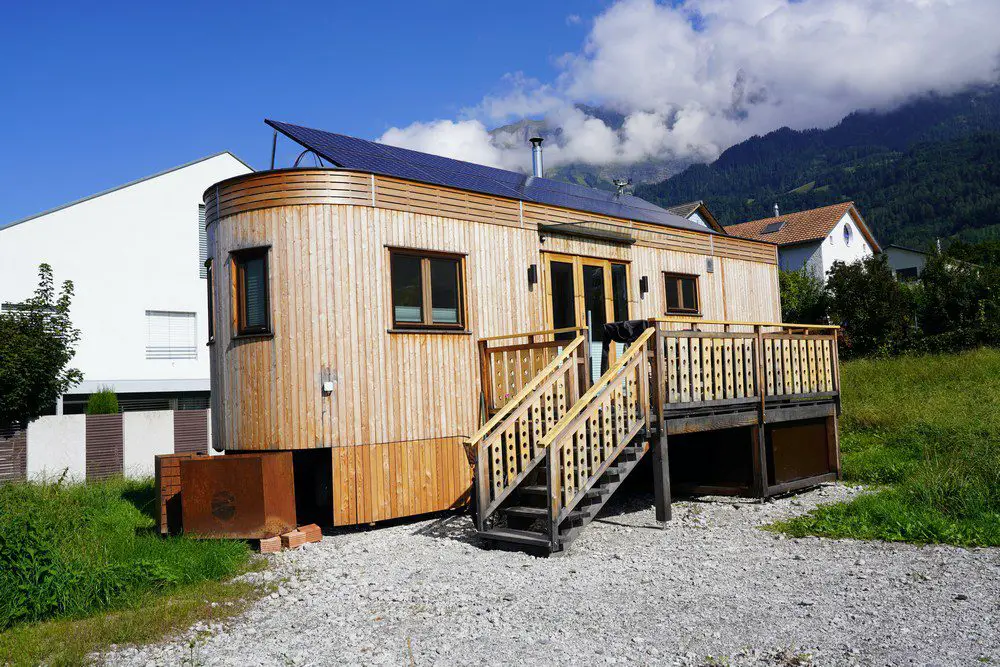Tiny houses have captured imaginations around the world. The small living space comes with its own financial and customization benefits. On the other hand, tiny houses come with their complications.
This article covers the different benefits and disadvantages of building a tiny home.
Contents
- 1 What is a Tiny House?
- 1.1 The Pros of Building a Tiny House
- 1.2 The Cons of Building a Tiny House
- 1.3 FAQ About Building a Tiny House
- 1.4 Is it legal to live in a tiny house?
- 1.5 How do tiny houses get utilities?
- 1.6 Is a tiny house a good investment?
- 1.7 Can I have pets in a tiny house?
- 1.8 Do tiny houses have addresses?
- 1.9 How do you deal with limited storage?
- 1.10 Are tiny houses safe?
- 1.11 Can I move to my tiny house?
- 1.12 What is the time frame for building a tiny house?
- 2 Conclusion
What is a Tiny House?
A tiny house is a small living space that usually ranges from 100 to 400 square feet. They come in many shapes and forms, but they all aim to make the most of a compact living area. Some are built on trailers for mobility, while others are stationary and built on traditional foundations. Now, let’s dive into what makes these homes unique and how they are typically constructed.
Key Features
The main goal of this structure is efficient use of space. They often have open floor plans and multi-purpose rooms to maximize usability. For instance, a living room might also serve as a dining area. Vertical space is also used with features like lofted beds or high shelves.
Construction Methods
When it comes to building a small house, there are various methods. Some people opt for a DIY approach, buying plans and materials to construct it themselves. Others purchase pre-made tiny homes or hire professionals to build custom designs.
Common materials include wood for framing, metal for roofing, and energy-efficient windows to keep the small space well-insulated. Specialized small house trailers are also a popular base for those looking to have a mobile home.
Tiny houses are more than just small homes. They are a conscious choice for a different kind of lifestyle, one that prioritizes efficiency, simplicity, and, often, sustainability. Whether mobile or stationary, these compact dwellings make the most of every square inch.

The Pros of Building a Tiny House
Building a tiny house has gained popularity for many good reasons. From financial savings to a lighter ecological footprint, the benefits are diverse. We will cover the reasons for building a tiny house in this section.
The Financial Benefits
Tiny houses are great for your wallet. You can build one for much less money than a regular home. The cost of building a tiny house is around $30,000 to $60,000 if you use common materials. This means you can own your home faster and say goodbye to a 30-year mortgage.
The savings keep coming even after you move in. Bills for water, electricity, and heat go down because you’re taking care of a smaller place. And let’s not forget many tiny houses are built to save energy. You are essentially saving money and minimizing your carbon footprint at the same time when you build a tiny home.
Tiny houses are major financial wins for owners due to the costs of building them and the low energy consumption required. They cut down on both upfront and long-term costs, making it easier to achieve financial freedom.
Space Efficiency
One of the standout features of tiny houses is their clever use of space. Every square inch counts in a tiny home, which encourages smart design choices. Multi-purpose furniture, like couches that convert into beds or tables that fold against the wall, is common.
Storage is another area where tiny houses shine. You’ll often find built-in shelves, hidden compartments, and loft spaces that serve multiple functions. For example, stairs may double as drawers, or a countertop could hide extra storage. These solutions help keep the home uncluttered while ensuring everything has its place.
Living in a small space encourages you to keep only what you truly need. Buying furniture and appliances you only need can benefit you physically and mentally. It teaches you to value what you have and to make thoughtful choices about new acquisitions.

Environmentally Friendly
Tiny houses have a big impact when it comes to environmental benefits. First off, they require fewer materials to build. This reduces the demand for natural resources like wood and metals. Tiny home builders often opt for sustainable, recycled, or upcycled materials, making the construction process even greener.
Because they’re small, tiny houses use less energy. Heating and cooling a small space takes less effort than a large home, lowering energy consumption. Many tiny houses also have solar panels or other renewable energy sources, decreasing their carbon footprint.
Water usage is another area where tiny homes excel. With less space for things like large bathtubs or multiple sinks, water consumption tends to be lower. Some homes even feature water recycling systems that make the most of every drop.
Choosing to live in a tiny house is a strong environmental statement. It shows a commitment to reducing your impact on the planet. These homes offer a way to live a full life while being mindful of the world around us, proving that small choices can lead to big changes.
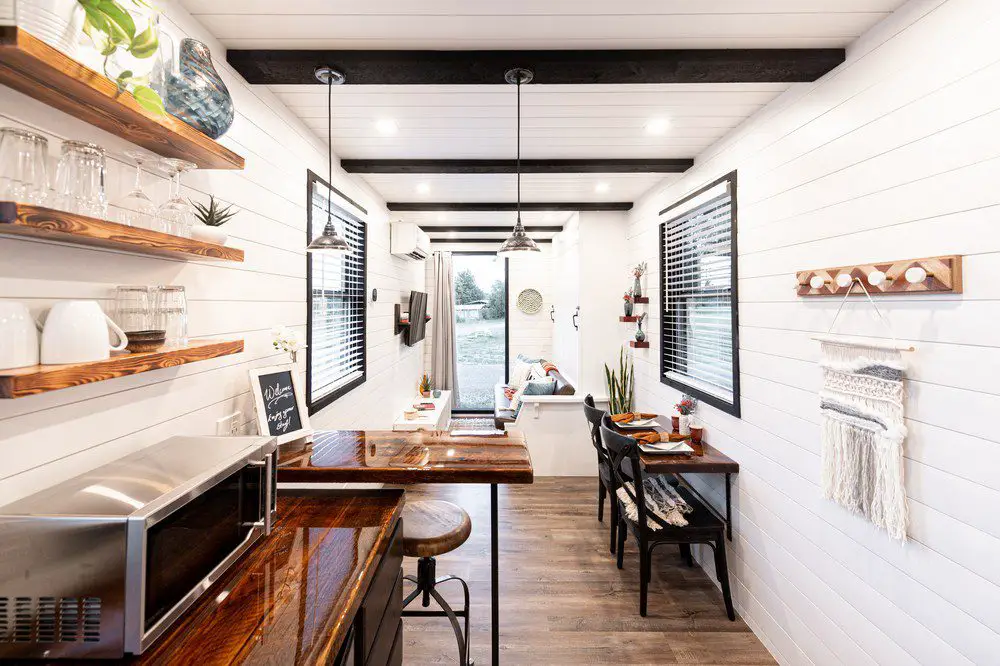
Sense of Community
Tiny houses often foster a strong sense of community, especially in tiny villages or communities. These places bring together like-minded people who share similar values, such as sustainability and minimalism. Living nearby naturally encourages interactions and creates a social network that’s hard to find in more traditional settings.
Shared amenities are common in tiny house communities. You might find communal gardens, shared laundry facilities, or a common house for group meals and events. These shared spaces provide opportunities to connect and collaborate, enhancing the sense of community even more.
The tight-knit feel also offers a layer of security. Neighbors are more likely to look out for each other when everyone knows and trusts one another. This creates a safer environment for all residents.
In a world where many people feel isolated, the strong sense of community in tiny house living stands out. It offers a social richness that’s hard to find in larger, more impersonal settings. For those who value community, a tiny home can provide more than just a place to live; it offers a place to belong.
Easy to Clean
One of the practical benefits of tiny house living is the ease of cleaning. With less square footage, there’s simply less to clean. Sweeping, mopping, and dusting take a fraction of the time in a larger home.
The small space to clean frees up time for other activities and reduces the stress associated with household chores. Many people find that a cleaner home leads to a clearer mind, adding to the mental benefits of tiny house living.
Greater Connection with Outdoors
Tiny houses often come with the added benefit of a greater connection to nature. The small indoor space encourages residents to venture outside more often. Whether your tiny house is parked in a rural area or a tiny house community, the limited indoor area makes the outdoors an extension of your living space.
Many tiny homeowners add decks or patios to increase this outdoor living area. This natural connection can enhance your well-being and offer a daily dose of the outdoors, which many crave.
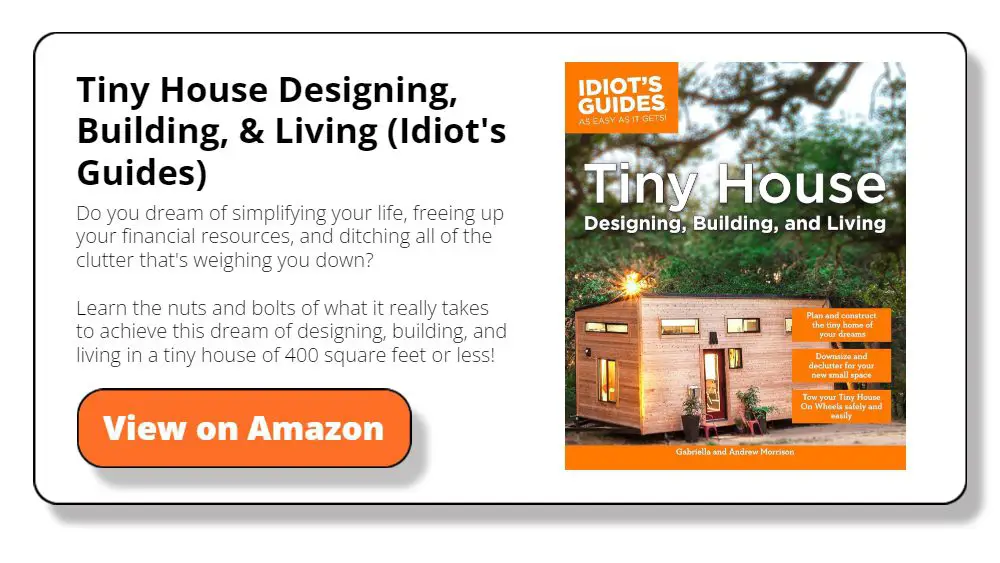
Easy to Customize
One of the best parts of tiny house living is the ability to customize your space easily. Since the area is small, even minor changes can have a big impact. You can choose the finishes, colors, and fixtures that reflect your style without breaking the bank. From a rustic interior to a modern look, the choices are all yours.
Plus, DIY projects are more manageable due to the smaller scale, allowing for more hands-on involvement in making the space your own. Customizing a tiny house can be not only easier but also more satisfying. You end up with a home that truly reflects who you are, built to suit your needs and tastes.
Lower Insurance Costs and Taxes
Financial perks extend beyond just the initial cost and upkeep of tiny houses. Because these homes are smaller and less valuable than traditional homes, insurance costs are generally much lower. It can result in significant savings over time, adding to the overall affordability of this lifestyle.
Similarly, property taxes are often lower for tiny homes, especially if they’re classified differently than traditional homes. These reduced costs make it easier to maintain financial freedom and save for other life goals. Coupled with the already lower costs of building and maintaining a tiny home, these additional financial benefits make a strong case for considering this unique way of living.
The Cons of Building a Tiny House
While tiny houses offer many benefits, they come with their own set of challenges too. From limited space to legal hurdles, these drawbacks can impact your living experience. In this section, we’ll explore the other side of the coin, giving you a well-rounded view of tiny house living.
Limited Space
The most obvious drawback of building a tiny house is the limited space. While the small size is part of the appeal for many, it also presents challenges. You have less room for belongings, making it essential to prioritize what you need. The limited space can be a struggle for people who are used to larger living spaces.
Activities like hosting dinner parties or having overnight guests become complicated. Even daily tasks like cooking can feel cramped in a tiny kitchen. For families, the limited space can make it difficult to find privacy or maintain separate activities.
While clever design can alleviate some of these issues, the fact remains that you’re working with a finite amount of room. This lack of space can become a problem for those who aren’t fully committed to a minimalist lifestyle.
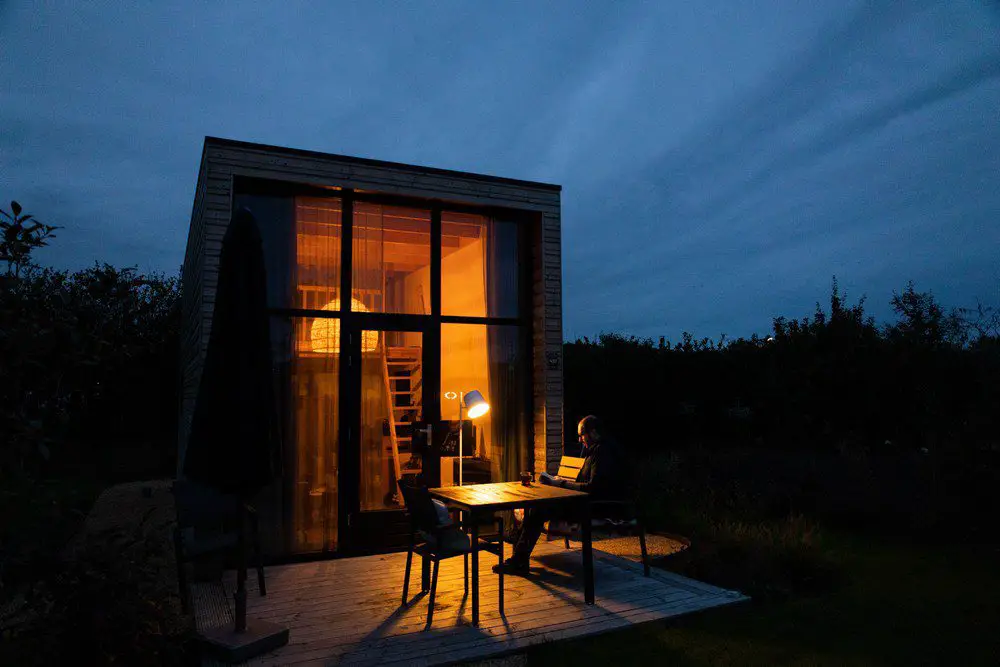
Zoning Laws and Building Codes
Legal hurdles can be one of the most challenging aspects of tiny house living. Many areas have zoning laws and building codes that aren’t friendly to tiny houses. These regulations often specify minimum square footage for new constructions, which tiny houses usually don’t meet.
Some places also have rules against living full-time in a structure on wheels, which many tiny homes are built on. Navigating these regulations can require much time and effort, including meetings with local planning commissions and potential legal fees.
Even if you’re committed to the tiny house lifestyle, the bureaucratic red tape can significantly hinder you. It’s essential to research and understand the laws in your chosen location before taking the plunge.
Mobility Issues
Living in a tiny house might seem like a mobile dream, but challenges exist. If your tiny house is on wheels, you’ll need a suitable vehicle. Transporting a tiny home isn’t as simple as hitching it to a truck and driving off. Special permits may be required, and the paperwork may take a significant amount of time, effort, and money to get.
The small size of the home also limits how much you can take with you during a move. If your tiny house is stationary, relocating involves selling your home or leaving it behind. Plus, frequently moving a tiny home can result in wear and tear, adding to maintenance costs. Mobility is often touted as a benefit of tiny homes, but it’s essential to understand the challenges involved.
Difficulties with Large Families or Pets
Tiny houses can be a tough fit for large families or people with multiple pets. The limited square footage makes giving everyone the space they need difficult. This could mean less room for play or study for families with children. Pets, particularly large breeds, might not have enough space to move around comfortably.
Activities like family dinners or simply watching a movie together can feel cramped. Sleeping arrangements can be particularly challenging, with limited options for privacy. The confined space may also contribute to feelings of cabin fever, making it important to have outdoor areas for recreation. While a tiny home’s minimalist, efficient lifestyle is attractive, it can pose practical difficulties for larger families and pet owners.
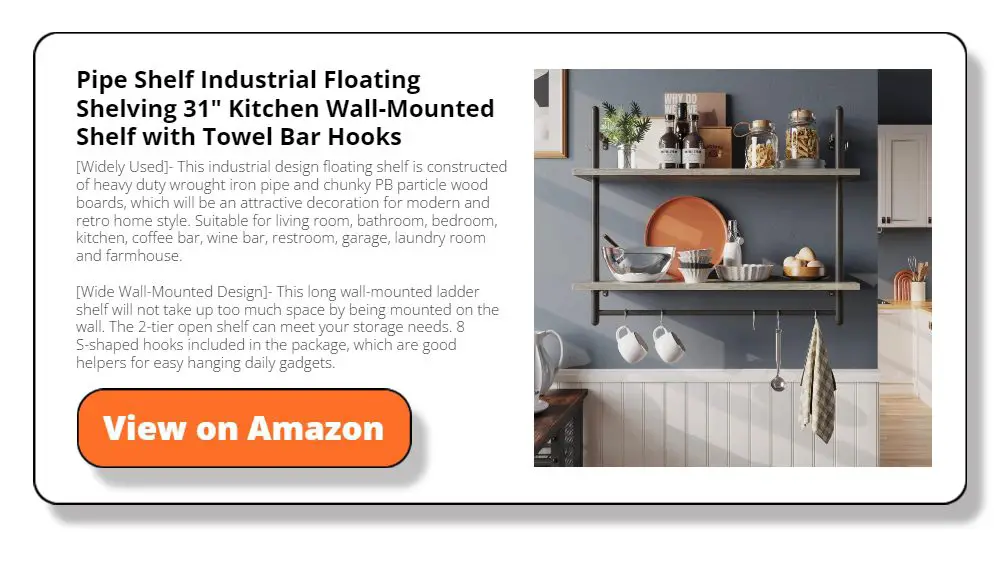
Challenges with Resale Value
Selling a tiny house comes with its challenges, and resale value is at the top. While tiny homes are less expensive to build, they also often appreciate less than traditional homes. One reason is that they often sit on leased or rented land. Since the land is not part of the sale, the home’s overall value is reduced.
Another hurdle is the niche market. Tiny houses appeal to a specific audience interested in downsized living. This limits the pool of potential buyers when it’s time to sell. Unlike conventional homes, which usually appeal to a broader market, you might find it takes longer to sell your tiny house.
Mortgage financing can also be a barrier for potential buyers. Because tiny houses don’t always conform to standard building codes, buyers might struggle to secure a traditional mortgage. This could mean that a potential buyer needs to have cash upfront or take out a personal loan, which can have higher interest rates.
Then there’s the matter of wear and tear. Tiny homes, particularly mobile homes, may experience more rapid deterioration than stationary, traditional homes. Buyers will likely consider this, which could lead to a lower selling price.
Lastly, design customization could be a double-edged sword. While you may love your custom choices, they may not be to everyone’s taste. This can make the house harder to sell and necessitate modifications to make it more marketable.
FAQ About Building a Tiny House
Is it legal to live in a tiny house?
How do tiny houses get utilities?
Is a tiny house a good investment?
Can I have pets in a tiny house?
Do tiny houses have addresses?
How do you deal with limited storage?
Are tiny houses safe?
Can I move to my tiny house?
What is the time frame for building a tiny house?
Conclusion
Building a tiny house benefits you regarding money saved and a chance to be part of a small community. Conversely, you face challenges like limited space, legal hurdles, and potential issues with resale value.
Each person’s experience will differ, so weigh these factors carefully. Doing so will help you decide if the tiny house lifestyle aligns with your goals and needs. Understanding the good and the bad can lead to a more informed, satisfying choice.

